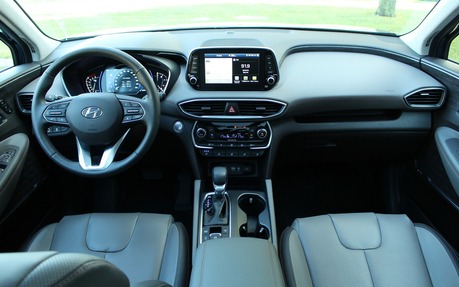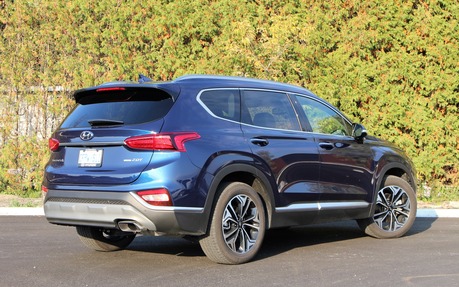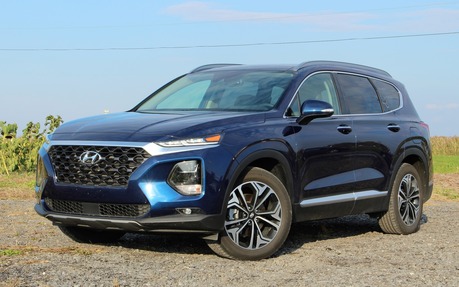2019 Hyundai Santa Fe: A Step Up
Like many Korean cars and SUVs, the Santa Fe has evolved quite a bit since its introduction on our market in 2000. The completely overhauled fourth-generation model has been on sale for a about a year now, bigger and more refined than ever.
The new styling draws the 2019 Hyundai Santa Fe closer to the design of its popular little brother, the Hyundai Kona, as well as its new big brother, the Hyundai Palisade. The headlights are mounted low on the front fascia, as the very slim clusters crammed between the hood and the grille are actually LED driving lights. While the previous Santa Fe had a more rugged appearance, the new one is all about sophistication and elegance, as if Hyundai is trying to move upmarket—which it can no longer do since the creation of the Genesis luxury brand spinoff.
- Also: 10 Things you Need to Know About the New 2019 Hyundai Santa Fe
- Also: 2020 Hyundai Palisade Priced Lower than the Kia Telluride
If the Santa Fe used to straddle the compact and midsize segments, the slight gain in dimensions push it out of the compact class. It now directly competes with five-passenger SUVs such as the Ford Edge, GMC Acadia and Nissan Murano, not to mention newcomers Honda Passport and Chevrolet Blazer.
Cloth upholstery is standard in the two more affordable trim levels—Essential and Preferred—while leather is included in the Luxury and Ultimate variants. Other standard features include heated front seats, a heated steering wheel as well as an infotainment system with seven-inch touchscreen, four USB ports and Apple CarPlay and Android Auto integration. Otherwise, the Essential trim serves mainly to boast a base price of $28,999 before freight and delivery charges.

Moving up to the $35,099 Preferred trim is a good, move since it includes all-wheel drive in addition to a power driver’s seat, dual-zone climate control, a sound system upgrade with SiriusXM compatibility as well as a slew of advanced safety features like adaptive cruise control, forward collision warning with emergency braking and pedestrian detection, blind spot monitoring with rear cross traffic alert, driver drowsiness detection and rear park sonar. It also adds what Hyundai calls Safe Exit Assist, which temporarily locks the rear doors if approaching vehicles are detected, preventing occupants from stepping out and getting injured—a clever feature for kids.
Our Ultimate tester piles on the comfort and convenience items, including a panoramic sunroof, LED headlights and taillights, rain-sensing windshield wipers, a power tailgate, ventilated front and heated rear seats, a surround view camera system, head-up display, a wireless charging pad as well as a 12-speaker, 630-watt sound system. The price swells up to $45K, which is still reasonable.
Overall, the interior design is classy and just as elegant as the Santa Fe’s sheetmetal, with just the right amount of brightwork and—in our test vehicle, at least—some woodgrain panelling. Space is good for all five occupants, the window surface is expansive for outward visibility and the seats offer a high level of support and comfort. The infotainment system is easy to use, although the touchscreen and its surrounding buttons can be a far reach for some drivers.
As for cargo space, the 2019 Hyundai Santa Fe offers a volume of 1,017 litres with the rear seats in place, and 2,019 litres when the seatbacks are folded down to create a flat load floor. That’s good for the market segment, although the Honda Passport is much more accommodating.
The Santa Fe’s base powerplant is a 2.4-litre, four-cylinder mill that develops 185 horsepower, mated to an eight-speed automatic transmission. It can handle the task of moving the SUV around with a full load of people on board, but some might feel it lacking in low-end torque—especially when connected to the all-wheel drivetrain. The turbocharged 2.0-litre four that’s optional in the Preferred trim and standard in the Luxury and Ultimate editions provides much more satisfying performance, with 235 horses and 260 pound-feet. It can run on regular fuel, and the penalty at the pump in about 1 L/100 km compared the base engine. During our test, we managed an average of 10.2 L/100 km, which is pretty good.

However, the Ford Edge and its turbo 2.0-litre engine is more frugal, while the V6 engines in the Passport, Blazer and Murano and consume about the same amount of fuel as the Hyundai. Between a turbocharged four and a smoother, more refined V6, we’d clearly choose the six if there wasn’t a significative difference in fuel economy. The Santa Fe can pull up to 1,588 kilograms (3,500 lbs) while the Blazer and Passport can tow up to 2,041 and 2,268 kg respectively. Even the Kia Sorento—the Santa Fe’s cousin—relies on a V6 engine instead of a turbo four in 2019, and it can pull up to 2,268 kg.
On the road, the Hyundai is refined, with good handling characteristics, but its steering feel could be better compared to its rivals, and suspension noise seeps up into the cockpit. The lane departure warning system is a little too sensitive, beeping constantly, to the point where we end up turning if off and making it irrelevant. Simply put, this new generation is a step up from the previous one, but overall, there’s nothing here to clearly justify purchasing the Santa Fe over the Blazer and the Passport.
Actually, there is one thing: the Hyundai offers a lot of features for the asking price. Combine that with its attractive new design, its comfortable cockpit and its great everyday practicality, and we can understand why so many Canadians choose the Santa Fe, which is easily outselling the Murano, the Acadia and the Passport so far in 2019.
| Test drive report | |
| Test model | 2019 Hyundai Santa Fe |
|---|---|
| Trim level | Ultimate 2.0T AWD |
| Price range | $28,999 – $44,999 |
| Price as tested | 45 199 $ |
| Warranty (basic) | 5 years/100,000 km |
| Warranty (powertrain) | 5 years/100,000 km |
| Fuel economy (city/highway/observed) | 12,3 / 9,8 / 10,2 L/100km |
| Options | N/A |
| Competitive models | Chevrolet Blazer, Chevrolet Traverse, Dodge Durango, Ford Edge, Ford Explorer, Ford Flex, GMC Acadia, Honda Pilot, Hyundai Tucson, Jeep Grand Cherokee, Kia Sorento, Mazda CX-9, Nissan Murano, Nissan Pathfinder, Subaru Ascent, Subaru Forester, Subaru Outback, Toyota 4Runner, Toyota Highlander, Volkswagen Atlas, Volkswagen Tiguan |
| Strong points |
|
| Weak points |
|
| Editor's rating | |
| Fuel economy | The 2.0-litre engine is efficient, but not any more so than the V6 engines found in rival SUVs. |
| Comfort | Spacious and versatile cockpit, supportive seats. |
| Performance | Good low-rpm torque, but lacks the muscular feel and sound of a good six-cylinder engine. |
| Infotainment | Easy-to-use layout, standard Apple CarPlay and Android Auto. However, the screen and its surrounding buttons can be a far reach. |
| Driving | Good ride quality, but suspension noise spoils the tranquility of the Santa Fe’s cabin. |
| Overall | A good SUV, in a segment that includes some great SUVs. |
